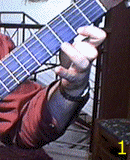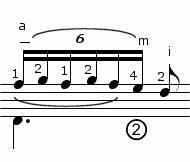
Gaspar Sanz, "Paradetas" (TAB)
Transcription and Fingering: Renato Bellucci
Folk music, is the music used to feel closer to a geographical location or group of people. Folk music is transmitted from generation to generation through performance and not through standard music notation. This explains why the existing transcriptions of the same piece by Gaspar Sanz, Alonso Mudarra, Luis Milan etc., are quite different from one publication to the next. These composers, often left simply a few ideas written on paper. The rest was to be filled in in by the performer.
Sanz elaborated quite a bit on folk music from Spain because he knew the guitar of the time thoroughly and went as far as he thought possible with his arrangements of popular tunes. Composers of many folk songs are often anonymous or forgotten because their music was seldom passed on in written form.
The musical form of Folk music is generally not standard form. The composer often sticks to a simple but effective musical idea and plays with it repeatedly (see the staff excerpt below). The words are therefore the improvised part, and often change from one generation to the next.
Paradetas is from a great artist with a solid technique and mastery of many pieces. I stress this because it is often thought that folk music is the music of the lower classes and of rural, poor populations. What is true is that folk music is essentially simpler and more compact than classical, or art music.
The modern equivalent of Sanz and Mudarra are Joan Baez, Bob Dylan, Cat Stevens and Dan Fogelberg.
This is the musical idea around which the whole piece rotates. It s to be played like a fast trill.
Add to playlist
Paradetas, Gaspar Sanz, Live in Buenos Aires, Argentina.
Staff and Video 1
String 6 is tuned down from a low E to a low D.
In the video, I play the first group at speed and the second much slower so as for you to pick the mechanics of the trill.

The trill sequence is essentially a circular motion. The finger that performs the trill (m in this case), performs both a pull-off (frames 1 & 2) and a hammer on (frames 3 & 4).
Video 1
Asunción, December 23, 2012
The continuation of this masterclass is in the members area, become a member today.
 Back to Top
Back to Top



